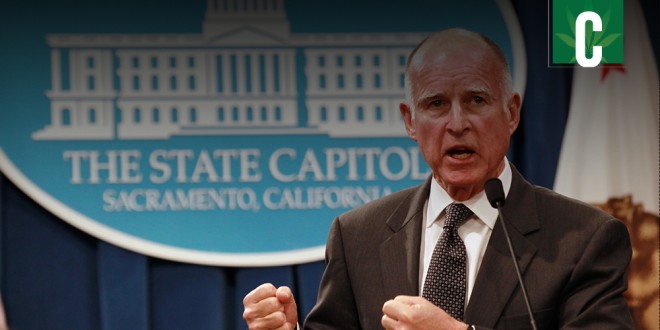It’s about time. After decades of legal chaos, California’s medical marijuana system is now subject to real, enforceable state regulations.
 Gov. Jerry Brown signed three bills in early October that impose new rules on the famously lawless MMJ industry. It marks the first time since medical weed was legalized in 1996 that the state has had the power to truly regulate the marijuana market.
Gov. Jerry Brown signed three bills in early October that impose new rules on the famously lawless MMJ industry. It marks the first time since medical weed was legalized in 1996 that the state has had the power to truly regulate the marijuana market.
Brown’s office announced his signature Oct. 9. The new laws are a major accomplishment for a state that was deeply fractured over its MMJ policies for many years. Though the regulations could make life more stringent for providers, most support them.
That’s because the very lack of regulation threatened the future of medical pot. The federal government has essentially promised to back off states that legalize the drug for medicine or recreation – as long as they enforce certain federal priorities, such as keeping weed away from kids.
Lack of regulation hinders legalization efforts
California’s anarchic system offered a ripe target for federal prosecutors hungry to take down medicinal cannabis. Former U.S. Attorney Melinda Haag, whose office represents the Bay Area and large parts of Northern California, resigned earlier this year after a long campaign to shutter countless dispensaries.
With new, tougher rules, reform advocates hope to squelch the federal threat. They also see this as a chance to ready the state for full legalization.
That issue will likely be on the ballot next year, and support for legalization is strong in most opinion polls. But the weaker California’s MMJ structure, the less likely voters would tolerate a new, recreational system.
“Given the history and complexity of California’s market, achieving the people’s will and responsibly regulating marijuana will be a process that unfolds over many years, requiring sustained attention to implementation,” said Lt. Gov. Gavin Newsom, who plans to run for governor in 2018.
Newsom, like Brown, supports medical cannabis reform, but the two men differ on full legalization – Newsom favors it while Brown does not.
Statewide licensing system
 The new rules will create a statewide licensing system for medical marijuana dispensaries. Under the original Compassionate Use Act of 1996, regulatory powers lay almost entirely with local governments, many of which have banned dispensaries outright.
The new rules will create a statewide licensing system for medical marijuana dispensaries. Under the original Compassionate Use Act of 1996, regulatory powers lay almost entirely with local governments, many of which have banned dispensaries outright.
That has left the state with a haphazard patchwork of cities, counties, and other localities that either allow, restrict, or ban medical weed. Activists see this as an unworkable system and hope the newly crafted regulations will prevent the same kind of confusion when recreational legalization arrives.
The package of regulations requires that each marijuana provider obtain one of 17 different industry licenses. Each business will be limited in the number of licenses it can buy.
There will be separate licenses for indoor and outdoor growing, shipping, product testing, distribution, and various types of dispensaries. And several state agencies will be tasked with developing guidelines for how weed is packaged, how potent it is, how it is advertised, and which pesticides are used.
The rules preserve the right of California adults to cultivate small amounts of pot for medical use. But local governments will also still be allowed to ban dispensaries or tax them.
 California Marijuana Market Breaking "Marijuana News" from CA
California Marijuana Market Breaking "Marijuana News" from CA



One comment
Pingback: Q & A: How Would Legal Marijuana Work? - California Marijuana Market